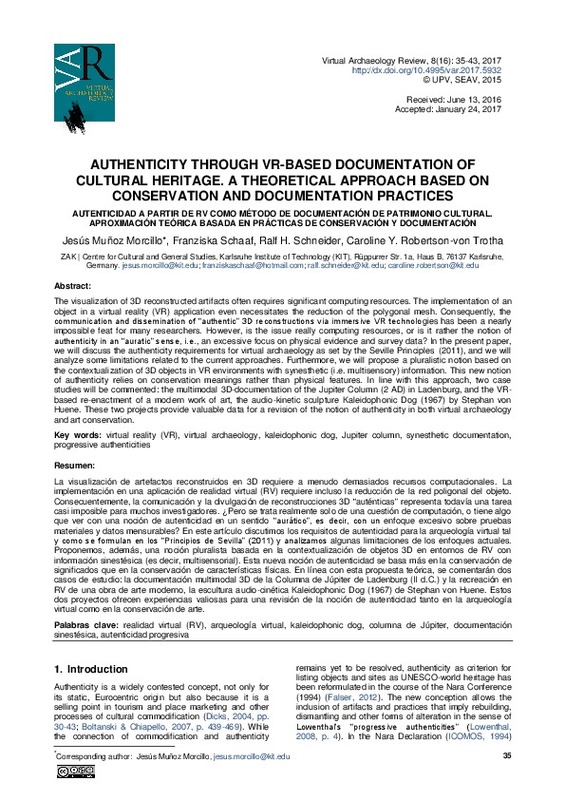JavaScript is disabled for your browser. Some features of this site may not work without it.
Buscar en RiuNet
Listar
Mi cuenta
Estadísticas
Ayuda RiuNet
Admin. UPV
Authenticity through VR-based documentation of cultural heritage. A theoretical approach based on conservation and documentation practices
Mostrar el registro sencillo del ítem
Ficheros en el ítem
| dc.contributor.author | Muñoz Morcillo, Jesús
|
es_ES |
| dc.contributor.author | Schaaf, Franziska
|
es_ES |
| dc.contributor.author | Schneider, Ralf H.
|
es_ES |
| dc.contributor.author | Robertson-von Trotha, Caroline Y.
|
es_ES |
| dc.date.accessioned | 2017-06-13T07:04:21Z | |
| dc.date.available | 2017-06-13T07:04:21Z | |
| dc.date.issued | 2017-05-22 | |
| dc.identifier.uri | http://hdl.handle.net/10251/82698 | |
| dc.description.abstract | [EN] The visualization of 3D reconstructed artifacts often requires significant computing resources. The implementation of an object in a virtual reality (VR) application even necessitates the reduction of the polygonal mesh. Consequently, the communication and dissemination of “authentic” 3D reconstructions via immersive VR technologies has been a nearly impossible feat for many researchers. However, is the issue really computing resources, or is it rather the notion of authenticity in an “auratic” sense, i.e., an excessive focus on physical evidence and survey data? In the present paper, we will discuss the authenticity requirements for virtual archaeology as set by the Seville Principles(2011), and we will analyse some limitations related to the current approaches. Furthermore, we will propose a pluralistic notion based on the contextualization of 3D objects in VR environments with synesthetic (i.e. multisensory) information. This new notion of authenticity relies on conservation meanings rather than physical features. In line with this approach, two case studies will be commented: the multimodal 3D-documentation of the Jupiter Column(2AD) in Ladenburg, and the VR-based re-enactment of a modern work of art, the audio-kinetic sculpture Kaleidophonic Dog(1967) by Stephan von Huene. These two projects provide valuable data for a revision of the notion of authenticity in both virtual archaeology and art conservation. | es_ES |
| dc.description.abstract | [ES] La visualización deartefactos reconstruidos en 3D requiere a menudo demasiados recursos computacionales. La implementación en una aplicación de realidad virtual (RV) requiere incluso la reducción de la red poligonal delobjeto.Consecuentemente,la comunicación y la divulgaciónde reconstrucciones 3D “auténticas”representa todavía una tarea casi imposiblepara muchos investigadores. ¿Pero se trata realmente solo de una cuestión de computación, o tiene algo que ver con una noción de autenticidad en un sentido“aurático”, es decir, con un enfoqueexcesivo sobre pruebas materiales y datosmensurables?En esteartículo discutimos los requisitos de autenticidad para la arqueología virtual tal y como se formulan en los “Principios de Sevilla” (2011) y analizamos algunaslimitaciones de los enfoques actuales. Proponemos,además,una noción pluralista basada en la contextualización de objetos 3D en entornos de RV con información sinestésica (es decir, multisensorial). Esta nueva noción de autenticidad se basa más enla conservación de significados que en la conservación de características físicas. En línea con esta propuesta teórica, se comentarán dos casos de estudio: la documentación multimodal 3D de la Columna de Júpiterde Ladenburg (II d.C.) y la recreación en RV de una obra de arte moderno, la escultura audio-cinética Kaleidophonic Dog(1967) de Stephan von Huene. Estos dos proyectos ofrecen experiencias valiosas para una revisión de la noción de autenticidad tanto en la arqueología virtual como en la conservación de arte. | es_ES |
| dc.description.sponsorship | This work was supported by the Stadt Karlsruhe (“Interdisziplinärer Fördertopf”) and the HEiKAResearch fonds (HEiKA, Heidelberg Karlsruhe Research Partnership) | |
| dc.language | Inglés | es_ES |
| dc.publisher | Universitat Politècnica de València | |
| dc.relation.ispartof | Virtual Archaeology Review | |
| dc.rights | Reconocimiento - No comercial - Sin obra derivada (by-nc-nd) | es_ES |
| dc.subject | Virtual archaeology, | es_ES |
| dc.subject | Virtual reality (VR) | es_ES |
| dc.subject | Kaleidophonic dog | es_ES |
| dc.subject | Jupiter column, | es_ES |
| dc.subject | Synesthetic documentation | es_ES |
| dc.subject | Progressive authenticities | es_ES |
| dc.subject | Realidad virtual (RV) | es_ES |
| dc.subject | Arqueología virtual | es_ES |
| dc.subject | Columna de Júpiter | es_ES |
| dc.subject | Documentación sinestésica | es_ES |
| dc.subject | Autenticidad progresiva | es_ES |
| dc.title | Authenticity through VR-based documentation of cultural heritage. A theoretical approach based on conservation and documentation practices | es_ES |
| dc.title.alternative | Autenticidad a partir de RV como método de documentación de patrimonio cultural. Aproximación teórica basada en prácticas de conservación y documetnación | es_ES |
| dc.type | Artículo | es_ES |
| dc.date.updated | 2017-06-12T07:20:56Z | |
| dc.identifier.doi | 10.4995/var.2017.5932 | |
| dc.rights.accessRights | Abierto | es_ES |
| dc.description.bibliographicCitation | Muñoz Morcillo, J.; Schaaf, F.; Schneider, RH.; Robertson-Von Trotha, CY. (2017). Authenticity through VR-based documentation of cultural heritage. A theoretical approach based on conservation and documentation practices. Virtual Archaeology Review. 8(16):35-43. https://doi.org/10.4995/var.2017.5932 | es_ES |
| dc.description.accrualMethod | SWORD | es_ES |
| dc.relation.publisherversion | https://doi.org/10.4995/var.2017.5932 | es_ES |
| dc.description.upvformatpinicio | 35 | es_ES |
| dc.description.upvformatpfin | 43 | es_ES |
| dc.type.version | info:eu-repo/semantics/publishedVersion | es_ES |
| dc.description.volume | 8 | |
| dc.description.issue | 16 | |
| dc.identifier.eissn | 1989-9947 |








